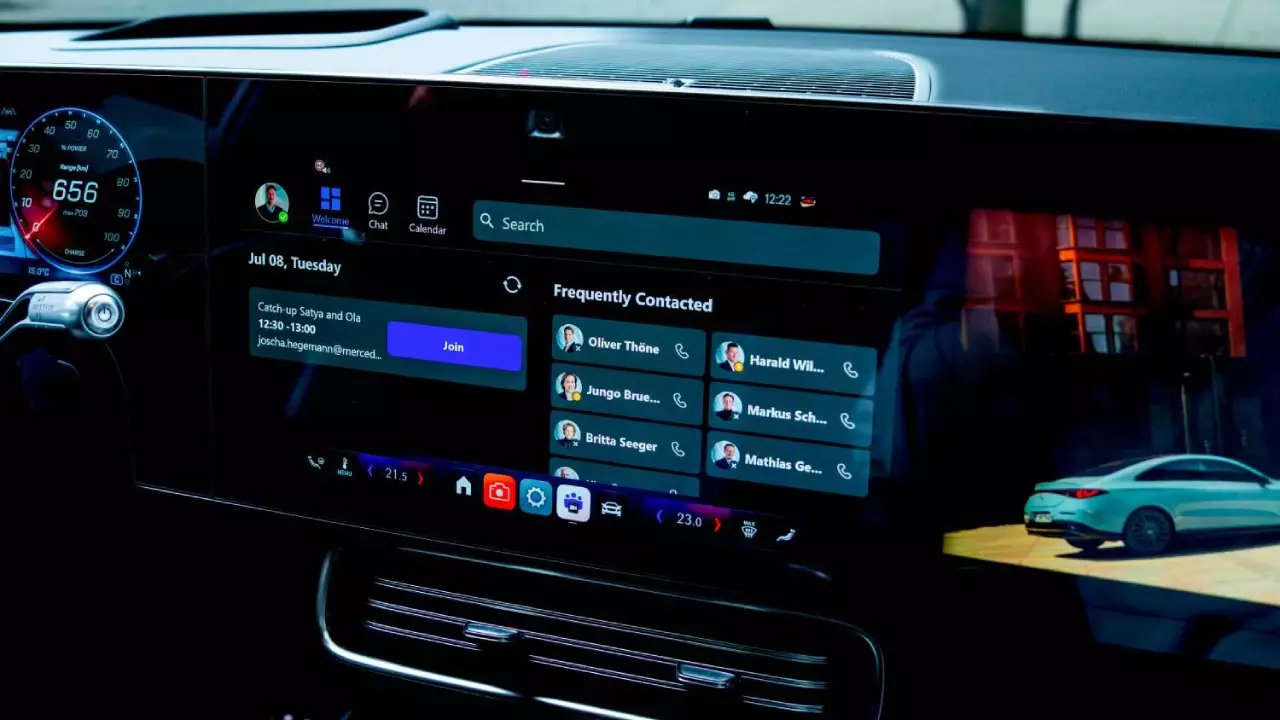In a world obsessed with projecting success, the latest Mercedes-Benz innovation attempts to merge luxury with productivity, presenting a compelling yet perplexing evolution of vehicle technology. The automaker’s new feature allowing drivers to stream live video of themselves during calls, while simultaneously driving, epitomizes a broader trend: the relentless pursuit of showcasing dedication, often at the expense of safety and practicality. While incrementally progressing toward smarter cars, such developments bear the heavy burden of scrutinous evaluation. Are these features genuinely advancing our daily lives, or are they dangerously leaning into a spectacle of modern vanity?
At the core, Mercedes’s update facilitates in-car Microsoft Teams use, including live video feeds of drivers during meetings. The premise sounds futuristic and aligned with the “work-anywhere” ethos, yet it raises immediate questions about necessity and safety. The official rationale claims that the feature is compliant with safety laws, with mechanisms in place to avoid driver distraction—such as automatic deactivation of video streams when the vehicle moves. However, even with these safety nets, one cannot ignore the underlying temptation for drivers to still engage visually or succumb to the allure of multitasking behind the wheel, potentially endangering everyone on the road.
This push for seamless digital collaboration in luxury vehicles underscores a paradox. Mercedes promotes that the driver cannot see meeting attendees or shared screens, ostensibly prioritizing safety. But is this enough? Is simply turning off the shared visuals truly addressing the core issue: the distraction of having a camera pointed at you while navigating traffic? The risk that someone might forget or deliberately choose to ignore the safety protocols looms large. Human error is inevitable, and relying heavily on automated safeguards might be naively optimistic. The reality is that a driver’s focus is a fragile commodity, especially when juggling work obligations in a high-end vehicle that signals status and success.
Beyond the safety critique, there is a broader cultural concern: the fetishization of productivity at all costs. Inserting live video feeds from a moving car into remote meetings might be viewed as a status symbol—an indication that the driver is so committed they can work from anywhere, even on the highway. This mentality dangerously normalizes blurring the boundaries between personal safety and professional obligation. It pushes an emerging narrative where physical limitations and safety protocols are secondary to the relentless pursuit of “being available” and “showing effort.” This not only erodes the boundary between work and life but also encourages risky behaviors dressed as modern innovation.
Moreover, the notion that these tech features somehow enhance productivity is questionable when examined critically. The addition of quick access to upcoming meetings or continuous chat integrations can streamline workflows, but it remains to be seen how much actual work happens during these in-motion video sessions. Does this truly make us more efficient, or does it serve as a status symbol reinforcing corporate culture’s obsession with constant connectivity? Human attention is finite; overlaying more digital stimuli on top of the task of driving is an inherently unstable formula. The real question is whether these features truly simplify our routines or merely complicate them, pushing productivity to an unsustainable extreme.
Mercedes’s move toward incorporating generative AI via Microsoft 365 Copilot further exemplifies this trend. Promising to help drivers prepare for meetings, summarize emails, and retrieve client information through voice prompts seems attractive on paper. Yet, it also raises profound concerns—AI’s track record for accuracy and reliability in safety-critical contexts is imperfect. Relying on AI for such functions in a moving vehicle introduces new vulnerabilities: misinterpretation, technological failure, or distraction caused by complex voice commands. We must ask ourselves if automating these tasks in an environment filled with noise and unpredictability genuinely uplifts productivity or inadvertently creates new hazards.
In essence, Mercedes’s latest innovations reflect a broader societal shift—one that values relentless connectivity and visual affirmation of effort, even at the expense of fundamental safety principles. While technological advancements have the potential to make transportation more efficient and integrated into professional life, they must be approached with a critical consciousness. Luxury and innovation should not come at the cost of safety or human sanity. As we embrace these shiny new features, the fundamental question remains: Are we designing cars to serve us better or merely fashioning mobile stages for digital displays of ambition? The answer lies in our willingness to prioritize human life over corporate spectacle.

